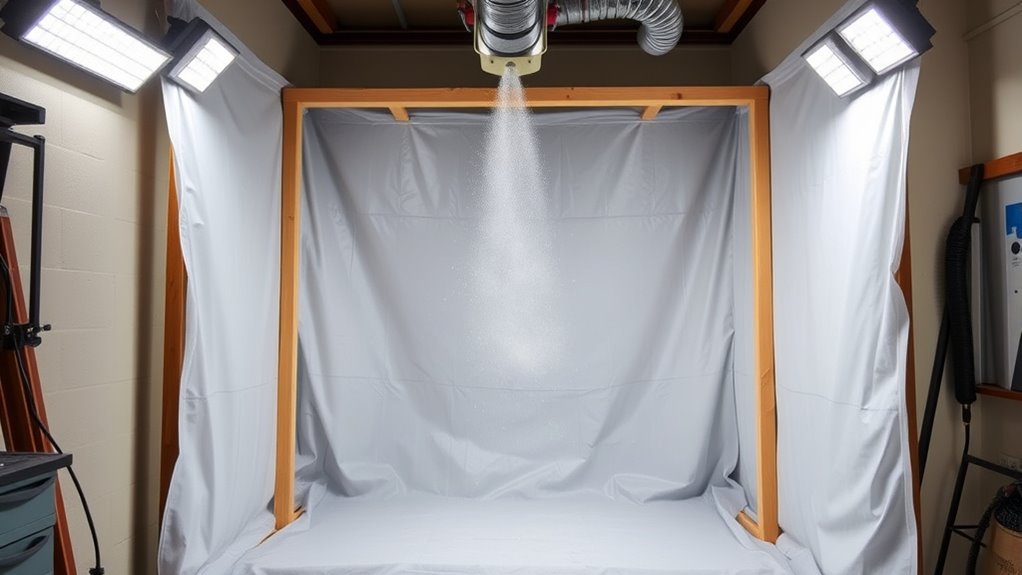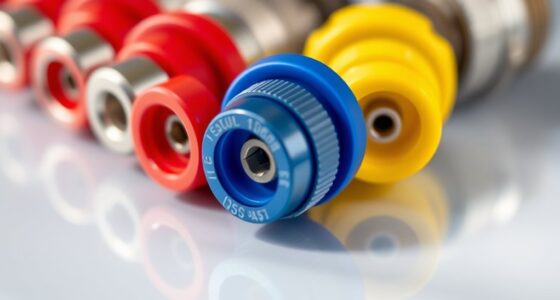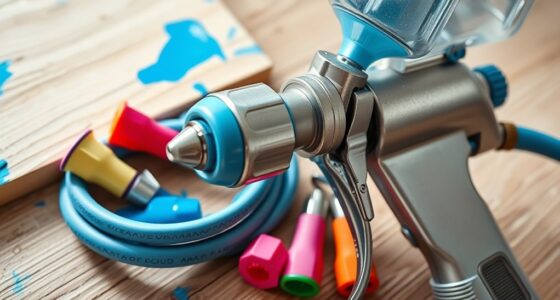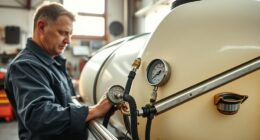To set up an affordable DIY spray booth that contains overspray, focus on creating proper ventilation with an exhaust fan at one end to draw air out and intake vents at the front or bottom for fresh air. Use filters like furnace filters or foam to prevent dust from entering, and seal any gaps to maintain negative pressure. Balancing airflow, controlling turbulence, and ensuring airtightness will improve results and safety—continue to explore ways to optimize your setup.
Key Takeaways
- Use a high-quality exhaust fan to create negative pressure and effectively draw overspray and fumes out of the booth.
- Incorporate affordable filters like furnace filters or fleece at intake vents to prevent dust from entering the workspace.
- Seal all gaps and leaks with weatherstripping or sealant to contain overspray and maintain a controlled airflow.
- Position intake vents at the front or bottom and exhaust at the top or rear for optimal airflow and overspray containment.
- Balance fan speed and vent sizes to achieve proper airflow, preventing turbulence and ensuring a safe, professional finish.
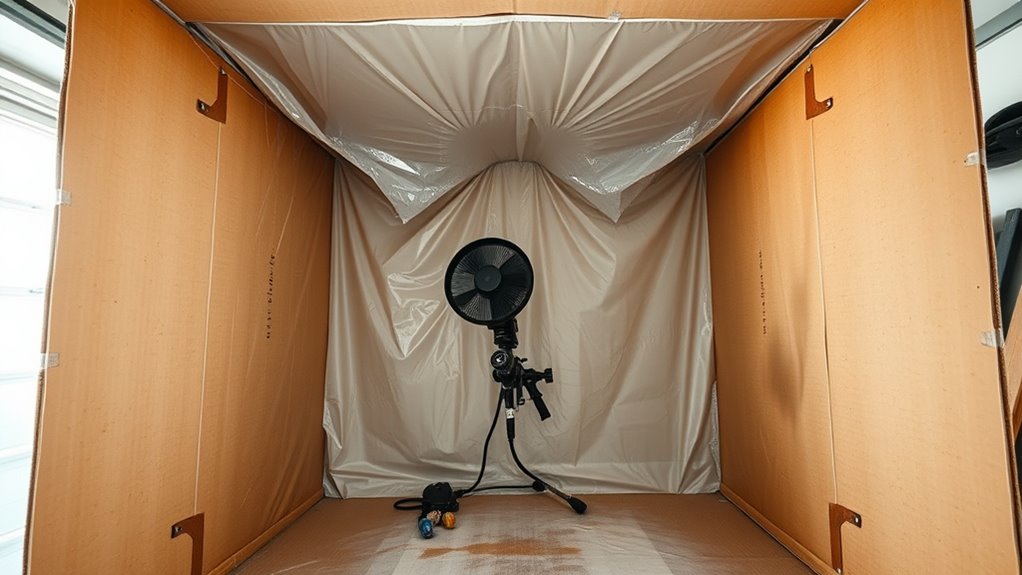
Creating your own spray booth is a practical way to achieve professional-quality finishes at home. When setting up your DIY spray booth, one of the most important factors is guaranteeing proper ventilation systems. Good airflow is essential for both safety and result quality, as it helps remove overspray, fumes, and dust. Without adequate ventilation, airborne particles can settle on your freshly painted projects, ruining the finish and posing health risks. That’s why paying attention to DIY airflow is vital; it determines how effectively the booth clears out contaminants and maintains a safe environment.
Proper ventilation ensures safety and a flawless finish in your DIY spray booth.
To start, consider how you’ll create a controlled airflow that pulls overspray away from your work area. You don’t need expensive commercial systems; instead, you can repurpose or build simple ventilation setups. For example, installing a high-quality exhaust fan at one end of your booth can create negative pressure, drawing contaminated air out efficiently. Make sure the fan is powerful enough to circulate the air volume within your booth, which will depend on its size. A basic rule of thumb is to aim for at least 4-6 air changes per minute, meaning the entire air inside your booth is replaced that many times every minute.
Position your intake vents strategically to bring in fresh, filtered air. Using filters, such as furnace filters or DIY filters made from foam or fleece, helps prevent dust and debris from entering the airflow. Placing intake openings at the front or bottom of your booth allows clean air to flow in smoothly, while the exhaust vent at the top or rear pulls contaminated air out. This creates a continuous, unidirectional airflow that pushes overspray away from your workpiece, reducing buildup and improving finish quality.
Remember, the key to effective DIY airflow is balancing intake and exhaust. If your exhaust fan is too powerful compared to your intake, you might create negative pressure that pulls unfiltered air from unintended gaps, defeating the purpose. Conversely, if intake is too strong, it can cause turbulent airflow, leading to uneven spray patterns. Adjusting the size and placement of your vents and fan speed helps you find the perfect balance.
Finally, sealing any gaps or leaks around your booth is essential. Leaks can disrupt airflow patterns, allowing overspray to escape and dust to enter. Use weatherstripping, sealants, or plastic sheeting to make your booth as airtight as possible while maintaining proper ventilation. This way, you maximize containment of overspray and ensure consistent, professional-looking results. Proper airflow management is crucial for achieving high-quality finishes and safe working conditions in your DIY spray booth. With a thoughtful approach to ventilation systems and DIY airflow, your homemade spray booth can rival commercial setups, all while saving money and customizing your workspace.
Frequently Asked Questions
What Safety Precautions Should I Take During Setup?
When setting up your spray booth, you should prioritize safety by wearing protective gear like masks, gloves, and goggles to prevent inhalation and skin contact. Make certain your ventilation systems are properly installed and functioning to remove overspray and fumes effectively. Keep the area well-ventilated, and double-check all equipment for leaks or hazards. Taking these precautions helps protect your health and creates a safer workspace during your DIY project.
Can I Customize the Size of My Spray Booth?
Imagine building a spray booth so perfect, it feels like it was made just for you! Yes, you can absolutely customize its size to fit your space and needs. Whether you want a compact, portable design that moves with you or a larger setup for bigger projects, size customization is totally doable. Just plan carefully, and you’ll create a spray booth that’s just right — portable designs included!
What Types of Filters Work Best for Containment?
When choosing filters for containment, you want filter materials that trap overspray effectively while allowing airflow. HEPA filters are excellent for capturing fine particles, but you can also use activated charcoal filters for fumes. Regular filter maintenance is essential; check and replace filters often to guarantee proper containment and airflow. You’ll get the best results by selecting high-quality filter materials suited for your spray booth size and keeping up with routine maintenance.
How Often Should I Clean or Replace Filters?
Filter maintenance matters for maintaining a clean, consistent spray booth. You should follow a regular cleaning schedule—typically every few weeks or after a set number of uses—to prevent buildup and guarantee peak airflow. Replace filters when they’re visibly dirty, clogged, or no longer effective. Staying vigilant with your cleaning schedule keeps your workspace safe, stylish, and super-efficient, preventing overspray from overwhelming your setup and extending your filter’s lifespan.
Is a DIY Spray Booth Suitable for Professional Use?
A DIY spray booth can work for professional use if it’s built with industrial capacity in mind, ensuring good airflow and safety standards. While it may not match commercial setups, you can still achieve a professional finish with proper ventilation, filters, and maintenance. Just remember, for high-volume or intricate projects, investing in a commercial booth might offer better consistency and durability.
Conclusion
Setting up your DIY spray booth is like building a sturdy bridge—you’ll connect your workspace with safety and efficiency. By using affordable materials and clever ideas, you can contain overspray and keep your area clean. Remember, patience and attention to detail make all the difference. Once it’s set up, you’ll feel as confident as a painter with a perfect finish. Now, go ahead and create your own spray booth—your projects deserve that professional touch!
Franz came aboard the Paint Sprayer Zone team with a background in both journalism and home renovation. His articulate writing style, combined with a passion for DIY projects, makes him an invaluable asset. Franz has a knack for breaking down technical jargon into easy-to-understand content, ensuring that even the most novice of readers can grasp the complexities of paint sprayers.
